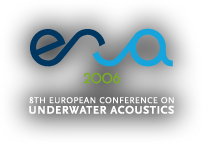

S.M. Jesus sjesus@ualg.pt
C. Soares csoares@ualg.pt
N.E. Martins nmartins@ualg.pt
Institute for Systems and Robotics, Universidade do Algarve,
Campus de Gambelas, PT-8005-139 Faro, Portugal.
Abstract
The estimation of ocean environmental properties by means of the inversion of acoustic signals
has in several occasions been performed using a single vertical array of acoustic receivers,
with a towed acoustic source as an attempt to ensure a rapid spatial coverage of the area of
interest, as only a single ocean transect is "seen" at each time.
Ideally, one would like to obtain an instantaneous picture of the complete area (volume) under
observation. However, the resulting acoustic observations, hence environmental estimates, are
not simultaneous in time. Using multiple acoustic receiving arrays appears to be a natural step
towards both increasing the spatial coverage, and obtaining simultaneous environmental estimates
of different ocean transects. It also gives a higher chance to capture spatial transient features,
as for example solitons.
Using multiple receiver arrays represents the addition of a new spatial dimension at the receiving
end and opens up the number of possibilities to a Nx2D or full 3D view of the ocean. Taking support
on the data set of the RADAR'07 experiment (July 9 - 16, 2007) where data was simultaneously
collected on three vertical arrays, this paper explores space coherent processing of the several
receiving arrays and Nx2D or 3D environmental constrained water coloumn matched-field inversion.